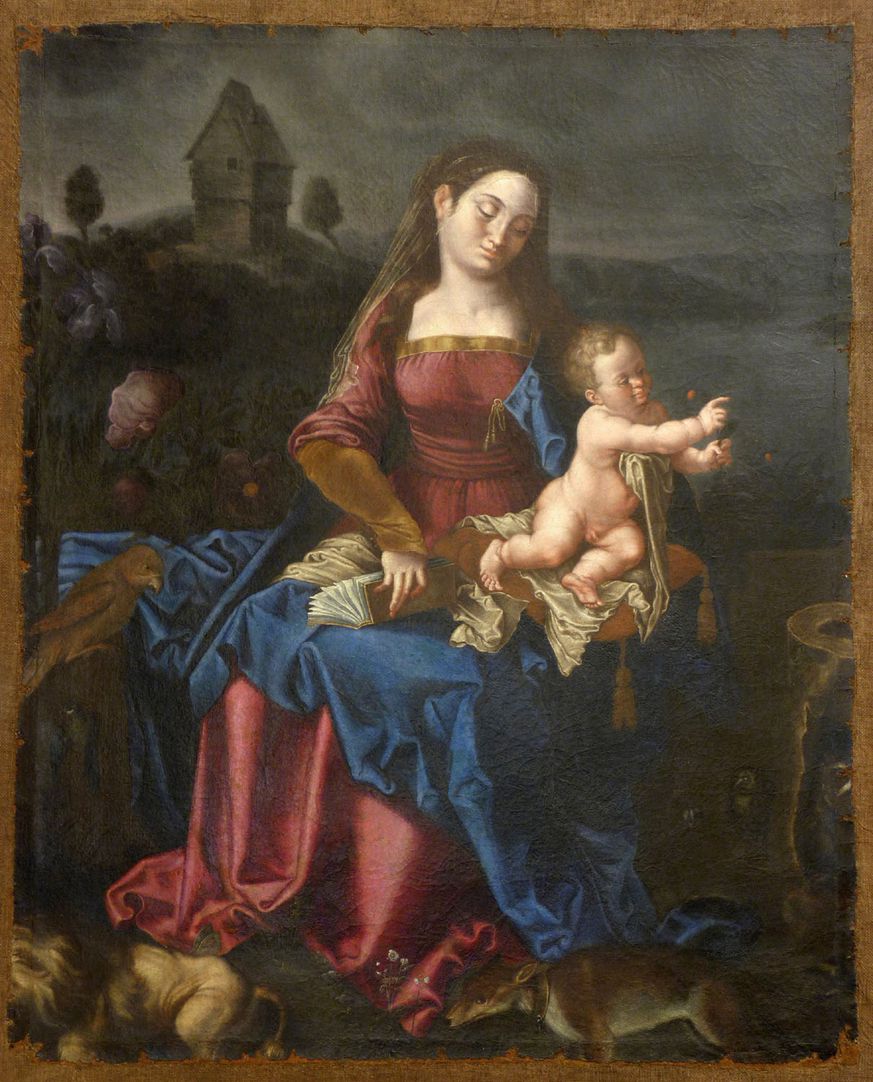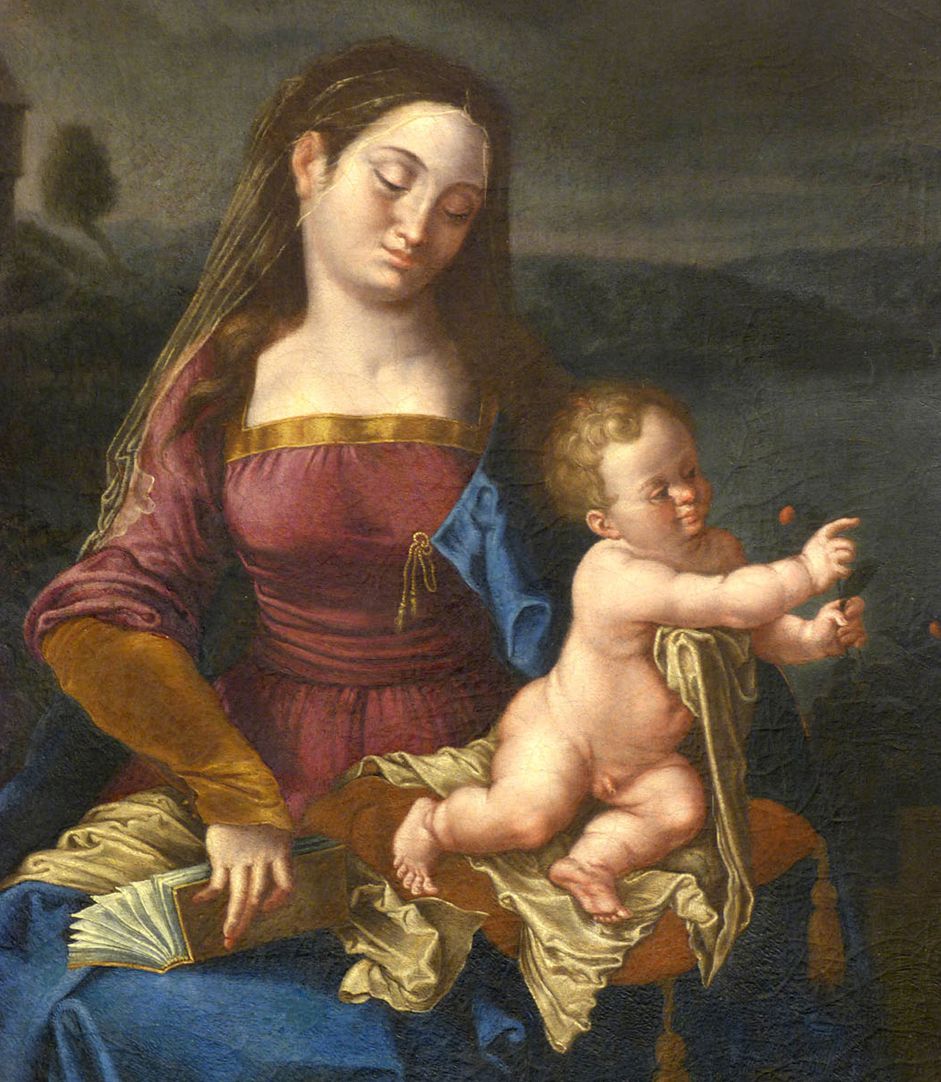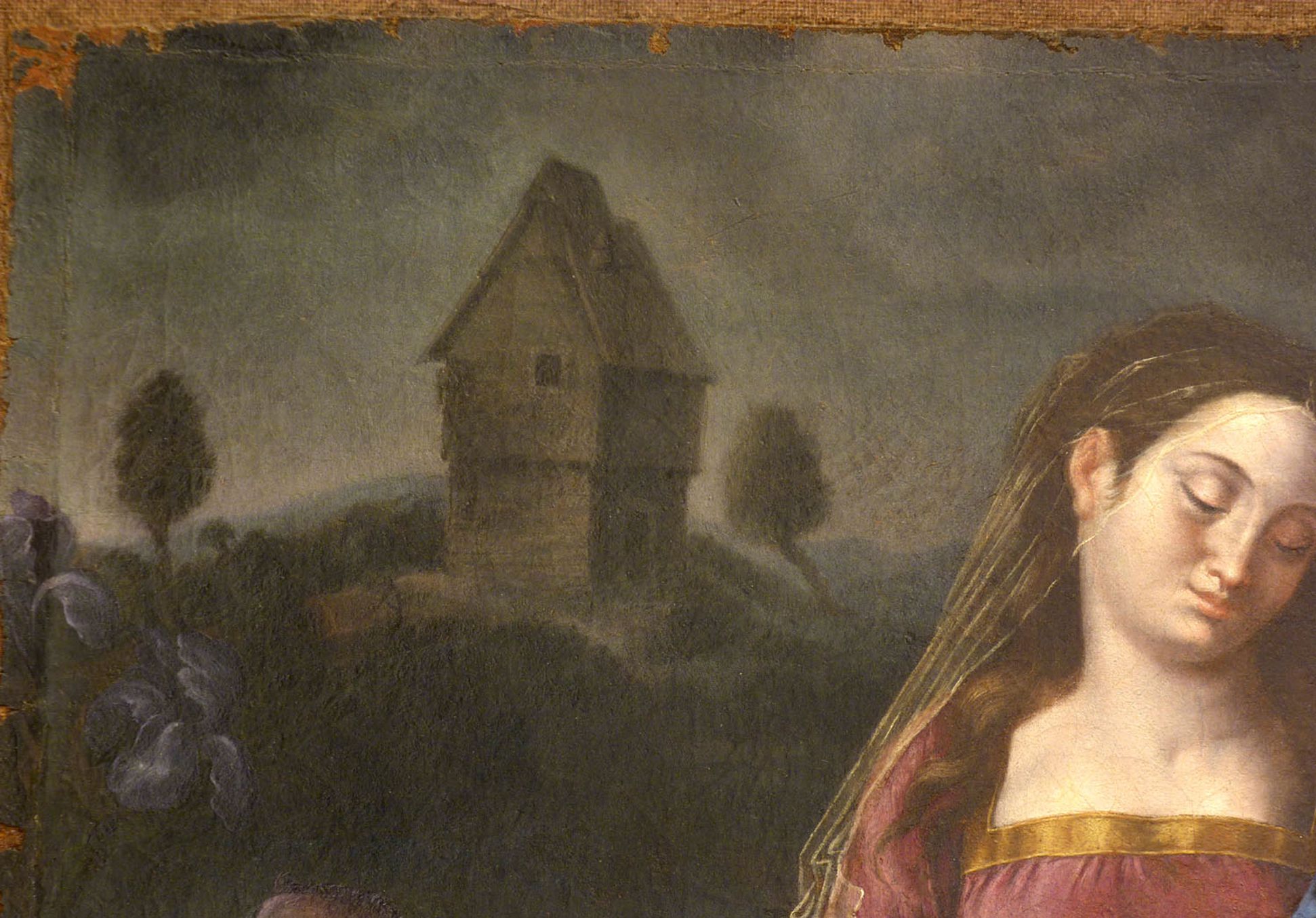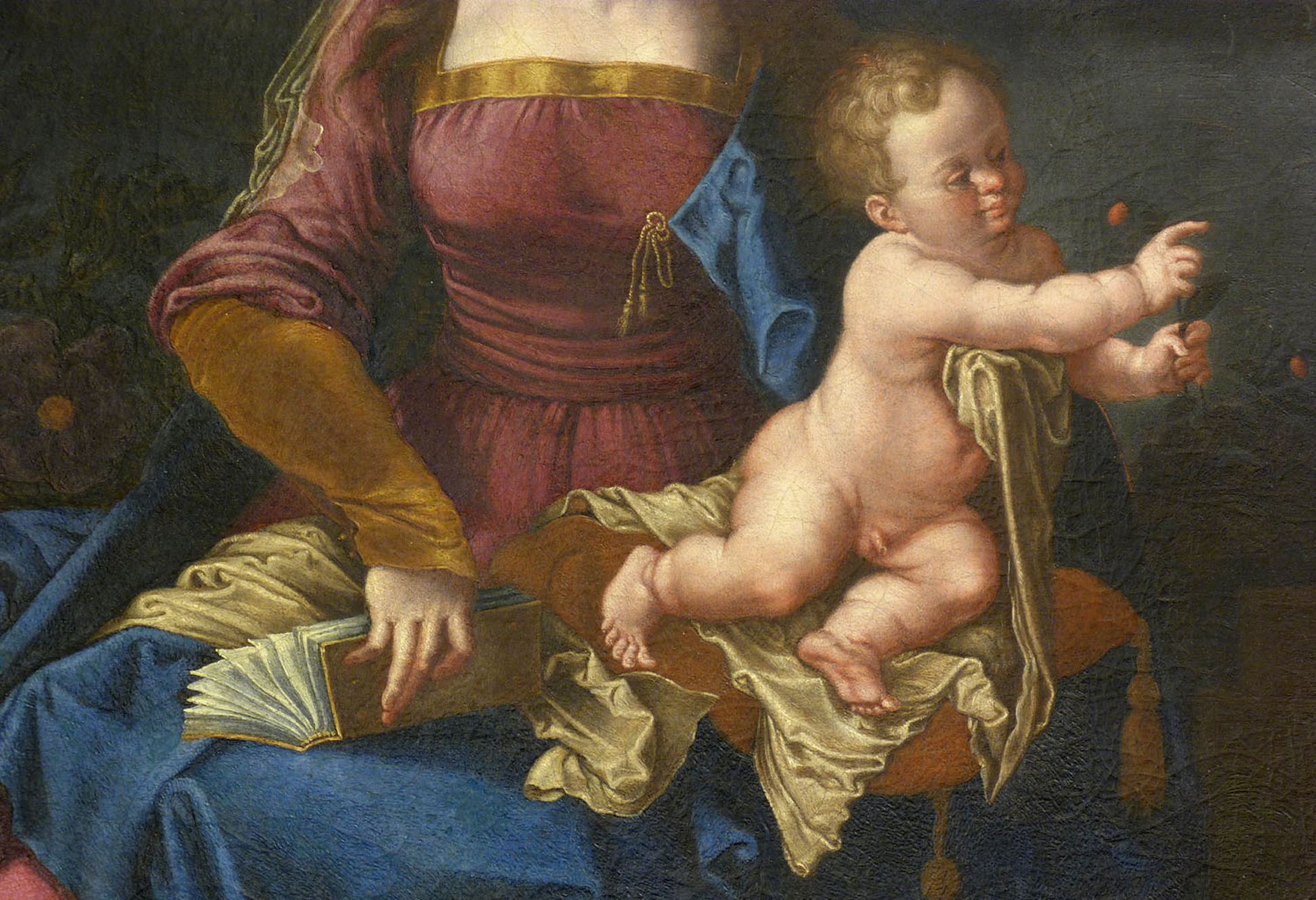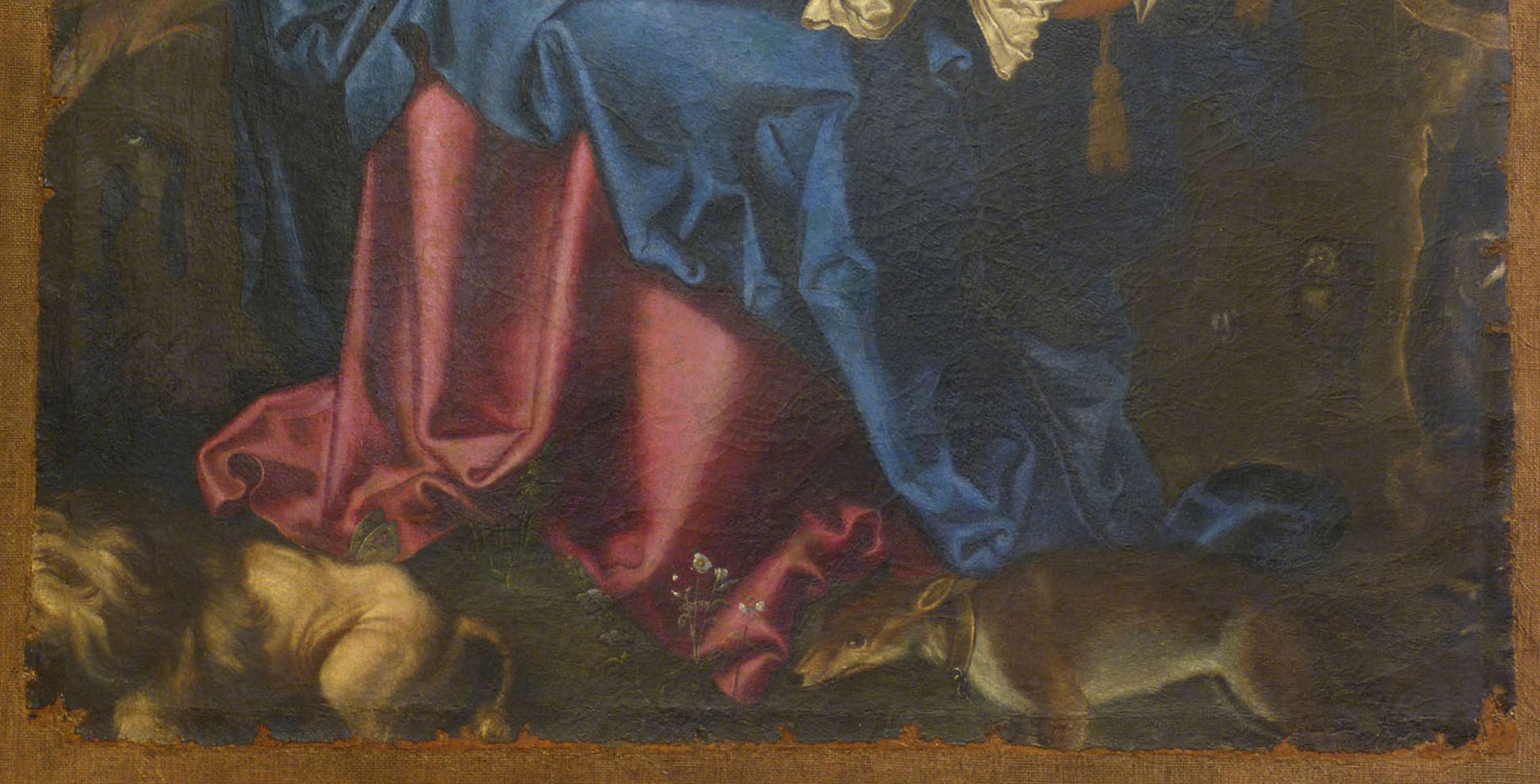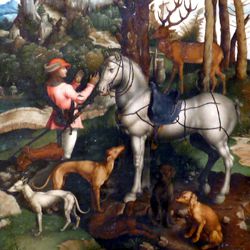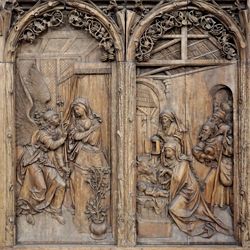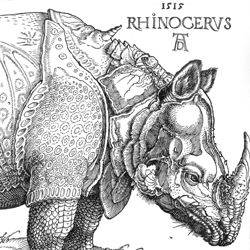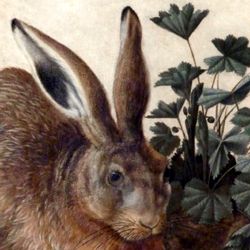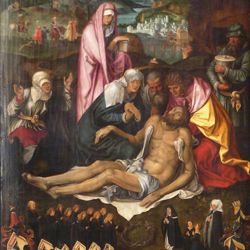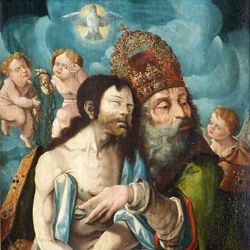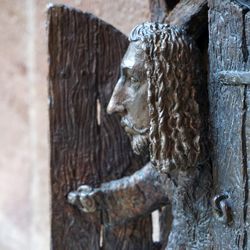Madonna degli Animali
Madonna degli Animali
17. Jh.
overall view
Not least because of Albrecht Dürer's trip to the Netherlands in 1520/21, his print work met with lively interest, especially there. Paintings by his hand, however, were hard to come by on the art market or were unaffordable. So if you couldn't own a real Dürer painting, you at least had the opportunity to have Dürer's prints converted into paintings. In this case, a presumably Flemish or Dutch painter around 1700 took the trouble to put Dürer's engraving “Madonna with the Vervet Monkey” on the canvas inverted. He was consciously not interested in an exact copy, but rather an independent “Dürer” picture, which thus became a paraphrase of several depictions of the Madonna by the Nuremberg master. Dr. Thomas Schauerte (2016) ___________________________________________ The painter combined two Dürerian models in his picture. For the background he used Dürer's reversed engraving of Mary with the Vervet Monkey and the little pond house (possibly after an reversed re-engraving). For the foreground motifs he used the engraving made around 1600 by Egidius Sadeler, who was appointed to the Prague court in 1597, based on Dürer's drawing of Mary with the Many Animals, which was in the possession of Emperor Rudolf II in Prague during Sadeler's time and is now in Vienna, Albertina is stored. For the reference to the engraving by Egidius Sadeler, Dr. Stefan Bartilla (May, 2022).
Location: Rome, Il Gesú, Museo
Realization: Dürer, Rezeption
photo 2016, Theo Noll
Madonna degli Animali
17. Jh.
Detail view
Not least because of Albrecht Dürer's trip to the Netherlands in 1520/21, his print work met with lively interest, especially there. Paintings by his hand, however, were hard to come by on the art market or were unaffordable. So if you couldn't own a real Dürer painting, you at least had the opportunity to have Dürer's prints converted into paintings. In this case, a presumably Flemish or Dutch painter around 1700 took the trouble to put Dürer's engraving “Madonna with the Vervet Monkey” on the canvas inverted. He was consciously not interested in an exact copy, but rather an independent “Dürer” picture, which thus became a paraphrase of several depictions of the Madonna by the Nuremberg master. Dr. Thomas Schauerte (2016) ___________________________________________ The painter combined two Dürerian models in his picture. For the background he used Dürer's reversed engraving of Mary with the Vervet Monkey and the little pond house (possibly after an reversed re-engraving). For the foreground motifs he used the engraving made around 1600 by Egidius Sadeler, who was appointed to the Prague court in 1597, based on Dürer's drawing of Mary with the Many Animals, which was in the possession of Emperor Rudolf II in Prague during Sadeler's time and is now in Vienna, Albertina is stored. For the reference to the engraving by Egidius Sadeler, Dr. Stefan Bartilla (May, 2022).
Location: Rome, Il Gesú, Museo
Realization: Dürer, Rezeption
photo 2016, Theo Noll
Madonna degli Animali
17. Jh.
Detail with Nuremberg Weiherhaus
Not least because of Albrecht Dürer's trip to the Netherlands in 1520/21, his print work met with lively interest, especially there. Paintings by his hand, however, were hard to come by on the art market or were unaffordable. So if you couldn't own a real Dürer painting, you at least had the opportunity to have Dürer's prints converted into paintings. In this case, a presumably Flemish or Dutch painter around 1700 took the trouble to put Dürer's engraving “Madonna with the Vervet Monkey” on the canvas inverted. He was consciously not interested in an exact copy, but rather an independent “Dürer” picture, which thus became a paraphrase of several depictions of the Madonna by the Nuremberg master. Dr. Thomas Schauerte (2016) ___________________________________________ The painter combined two Dürerian models in his picture. For the background he used Dürer's reversed engraving of Mary with the Vervet Monkey and the little pond house (possibly after an reversed re-engraving). For the foreground motifs he used the engraving made around 1600 by Egidius Sadeler, who was appointed to the Prague court in 1597, based on Dürer's drawing of Mary with the Many Animals, which was in the possession of Emperor Rudolf II in Prague during Sadeler's time and is now in Vienna, Albertina is stored. For the reference to the engraving by Egidius Sadeler, Dr. Stefan Bartilla (May, 2022).
Location: Rome, Il Gesú, Museo
Realization: Dürer, Rezeption
photo 2016, Theo Noll
Madonna degli Animali
17. Jh.
Detail with baby Jesus
Not least because of Albrecht Dürer's trip to the Netherlands in 1520/21, his print work met with lively interest, especially there. Paintings by his hand, however, were hard to come by on the art market or were unaffordable. So if you couldn't own a real Dürer painting, you at least had the opportunity to have Dürer's prints converted into paintings. In this case, a presumably Flemish or Dutch painter around 1700 took the trouble to put Dürer's engraving “Madonna with the Vervet Monkey” on the canvas inverted. He was consciously not interested in an exact copy, but rather an independent “Dürer” picture, which thus became a paraphrase of several depictions of the Madonna by the Nuremberg master. Dr. Thomas Schauerte (2016) ___________________________________________ The painter combined two Dürerian models in his picture. For the background he used Dürer's reversed engraving of Mary with the Vervet Monkey and the little pond house (possibly after an reversed re-engraving). For the foreground motifs he used the engraving made around 1600 by Egidius Sadeler, who was appointed to the Prague court in 1597, based on Dürer's drawing of Mary with the Many Animals, which was in the possession of Emperor Rudolf II in Prague during Sadeler's time and is now in Vienna, Albertina is stored. For the reference to the engraving by Egidius Sadeler, Dr. Stefan Bartilla (May, 2022).
Location: Rome, Il Gesú, Museo
Realization: Dürer, Rezeption
photo 2016, Theo Noll
Madonna degli Animali
17. Jh.
lower third of the picture
photo 2016, Theo Noll
Not least because of Albrecht Dürer's trip to the Netherlands in 1520/21, his print work met with lively interest, especially there. Paintings by his hand, however, were hard to come by on the art market or were unaffordable. So if you couldn't own a real Dürer painting, you at least had the opportunity to have Dürer's prints converted into paintings. In this case, a presumably Flemish or Dutch painter around 1700 took the trouble to put Dürer's engraving “Madonna with the Vervet Monkey” on the canvas inverted. He was consciously not interested in an exact copy, but rather an independent “Dürer” picture, which thus became a paraphrase of several depictions of the Madonna by the Nuremberg master. Dr. Thomas Schauerte (2016) ___________________________________________ The painter combined two Dürerian models in his picture. For the background he used Dürer's reversed engraving of Mary with the Vervet Monkey and the little pond house (possibly after an reversed re-engraving). For the foreground motifs he used the engraving made around 1600 by Egidius Sadeler, who was appointed to the Prague court in 1597, based on Dürer's drawing of Mary with the Many Animals, which was in the possession of Emperor Rudolf II in Prague during Sadeler's time and is now in Vienna, Albertina is stored. For the reference to the engraving by Egidius Sadeler, Dr. Stefan Bartilla (May, 2022).
Location: Rome, Il Gesú, Museo
Realization: Dürer, Rezeption
